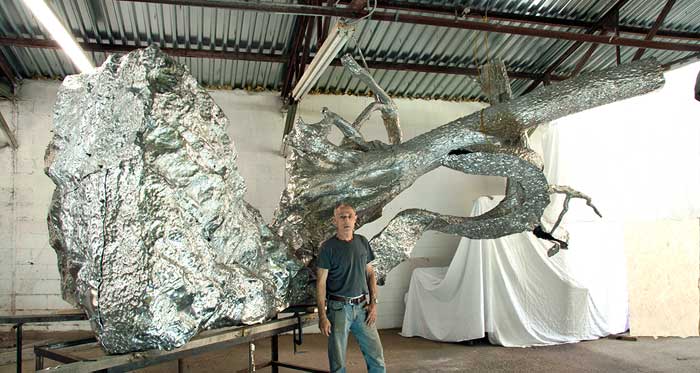
Robert Lobe, Sandy, 2017. Hammered aluminum, prior to heat treating. 113 x 118 x 211 in.
While flora and fauna have long attracted the creative eye, the contemporary artist who holds a mirror to nature must—if the resulting reflection is to be seen with clarity—satisfy a proclivity for the befogged. Render features apparent, allows the modern mandate, but do so in terms of forces dimly seen. If it all seems to constitute a rather challenging puzzle, this statement from the notebooks of sculptor David Smith suggests a resolving clue:
“The forward sculptor deals with nature, but his nature has changed from the bowl of fruit, the nude and the cloaked figure of virtue to new discoveries in nature” (The Concept of Vision).
By suggesting a new communion of artist with the world, those words elevate the kinetic to the status of the definitive. That’s just fine with Robert Lobe, whose recent sculptures are very like field reports from adventures of discovery in a forest lab doubling as studio, canvas and text. His reports seem to resolve our posed conundrum by bringing viewer and nature into a communion divorced from the stark lucidity of the stopped image and the disorienting jar of the aesthetic machine.
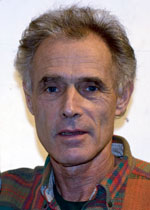
Robert Lobe
Lobe began his love affair with nature as a young man when the forest behind his Cleveland home offered an escape from the human tensions native to youth and a communion with life itself. His sculpture has long been informed by the writings of Barbara Novak, a pioneer in the elucidation of the process by which artists of the nineteenth century discovered in nature the iconological roots for their subject matter. In doing so, Novak identified a mutual mediation for culture and art. The former consisted of belief in a sublime infusion of governing principles into the environment, and a championing of a Manifest Destiny celebrating the natural world. Art’s icons, for their part, contained ideal echoes of moral principles, of a nature encharged with higher laws, and in doing so provided a justification for the human hand’s conformation of the world while acknowledging a trail of rotting stumps left by the ring of the axe and the shriek of the Iron Horse.
Lobe’s sculptures perceive this traditional aesthetic through a 21st century lens. Now the artist desires communion with nature, respecting its native forces. Iconic depictions of trees and rocks, governed by the science of natural selection rather than the mystery of providential destiny, urge a halt to the destroying power of the smokestack and the chemical plant. And Novak’s mediatory dynamic still maintains, as artistic labor is guided by the principles of a modern sensibility, creating works that, in turn, give sustenance to the common mindset. The result is a maintenance of that natural connection between man and plant that Emerson championed in Beauty more than a century ago: “All the facts in nature are nouns of the intellect, and make the grammar of the eternal language.”
While Lobe’s marriage with the forest might suggest roots in the earth art of the seventies, the artist long ago rejected that movement’s site-specific restrictions. “My work has gone from being in the earth, where it originated, to being portable,” he says. “My sculpture is not about the site, but about the idea.” The latter, we might infer, will relate in some way to the kinetic mandate of our opening conundrum.
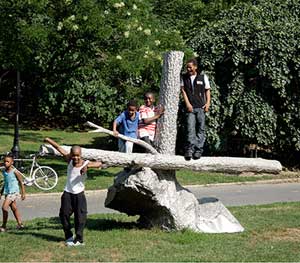
Robert Lobe, Antique Jenny, 2011. Heat-treated hammered aluminum. 11 x 5 x 13.5 ft.
But what, exactly, is the nature of the idea informing Lobe’s art? For one approach to an answer, consider Sandy, one of Lobe’s recent sculptures which found its genesis a few years ago when the artist encountered a fallen tree in the New Jersey woodlands which have long served as his outdoor studio. Downed by its titular hurricane, the tree had settled into an arresting posture. “This tree had an incredibly beautiful root structure,” recalls Lobe. “It was not very deep because it had been living, in a yin yang way, on a rock face tilted at a 40-degree angle. The tree reflected the form of the boulder from which it had been scraped away, and the trunk had spiraled into the sky. Its upper part had dropped down and was resting against another tree.”
Lobe at once identified this discovery as a promising subject for a sculpture. Following a procedure common to all his recent works, Lobe began to hammer flat sheets of aluminum around the trunk using pneumatic tools, impressing patterns of bark and limb into the metal. He describes this process as a variety of repoussé (from the French meaning to push up), a one-time important manufacturing technique still employed by jewelers and silversmiths. Because Lobe worked the same procedure on the adjacent boulder, which he saw as an integral part of a living unit, subtle differences in the metallic impression would communicate a duality of the organic and the inorganic. “Physically and mechanically the rock is a much harder surface,” explains Lobe. “It hammers very differently than the softer surface of the tree.” As is the case with all of Lobe’s sculptures, Sandy required many sheets of repoussé which would later be assembled into a finished work balancing natural representation and aesthetic suggestion.
Lobe compares his creative process to dress making. “I think of the tree as a woman,” he says. “I put clothes of metal on her.” The process begins with a mental plan corresponding to a clothing designer’s two-dimensional pattern, right down to the darts and pleats requisite for the development of a three-dimensional work. “The seams need to be organized, to overlap in certain ways,” he says. “I’m interested in the flow of the eye and the continuity of the surface.”
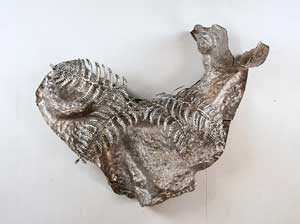
Robert Lobe, Fiddle Fern, 2013. Hammered aluminum, galvanized iron. 45 x 54 x 26 in.
As the above description suggests, Lobe’s sculptures involve more than simply impressing the surface of tree and boulder into aluminum. The artist’s skilled hand must create an aesthetic distance that convinces the viewer the work is a created thing. “The seams in the aluminum sheets and the hollows visible in the work show that none of this is real, that this is a fictitious piece of art,” says Lobe. At the same time the artifacts left by the hand must not draw undue attention to themselves. If the viewer attends to the pleats of the finished dress, after all, the tailor has failed. “I don’t want people to get obsessed with my technique and means,” he says. “I don’t want them to just say, ‘Oh my God, this guy worked his ass off.’ I want the work to be convincing. That requires that I organize the seams of the pattern in a way that convinces the viewer the story I am telling is nature’s story which I have made into an artist’s story.”
While Lobe’s techniques may seem to depart radically from the cast and carve of classical sculpture, Lobe believes his work does relate to the traditional practice of rendering images of natural objects in an inorganic material. “I’m able to incorporate what I think is the history of sculpture in a very fast-forward way,” he says. “I’m not trying to escape the past. I don’t find it a threat. I’m trying to move ahead with it, and I think I’ve extended the classical idea of sculpture with my technique. It’s more than just tapping aluminum around a tree. It involves the forming of a modern-day miracle metal.”
Despite these roots in the past, Lobe’s works are deeply informed by modernity. Any shop talk with the artist turns before long to an expression of enthusiasm about the work and thinking of David Smith, the previously-quoted sculptor whose innovations have had a profound effect on Lobe. Paramount here is Smith’s pushing of the boundaries of abstraction by rejecting the columnar container so restricting of traditional sculpture. “Smith is the sculptor who understood the container as a surface and not as an object,” says Lobe. “What the viewer sees as an edge of a solid mass in a Smith sculpture is created by welded beads buried deep between joining planes. That projects the planes, and it makes what is a hollow or empty form into what looks like a solid mass.”
In their rejection of the traditional container, many of Smith’s works fell into the category of what sculptor Donald Judd championed as “the new three-dimensional work” of “the specific object.” These terms identified an approach to art that rejected painting’s rectangular frame and sculpture’s vertical column. “Much of the motivation in the new work is to get clear of these forms,” Judd wrote in his influential 1964 essay Specific Objects. Contemporary sculpture, he said, should be free to enjoy “a space to move into” and that “because the nature of three dimensions isn’t set, given beforehand, something credible can be made, almost anything.”
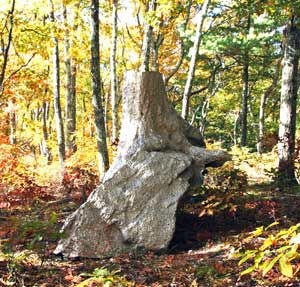
Robert Lobe, Good Morning America, 2014. Heat-treated hammered aluminum. 8.5 x 6 x 8 ft.
The freedom of the specific object is evident in Lobe’s works, which typically extend well beyond the borders of what has for centuries been acceptable sculptural boundaries. Lobe has even shaped some of his recent wall-reliefs to resemble paintings; his metal sheets might well remind the viewer of a flat canvas. That’s no accident, for Lobe sees his sculptures as sharing painting’s transmogrification of a two-dimensional surface into three-dimensional image. This dissolution of the boundaries of the two forms reflects, again, the thinking of David Smith who stated in The New Sculpture, “I do not recognize the limits where painting ends and sculpture begins.” In his early days Smith concentrated on painting, but his materials “developed into raised levels from the canvas” so that “gradually the canvas became the base and the painting was a sculpture.” Lobe’s work extends this formal merger into drawing. Rather than sketch out his ideas on paper and pen, he “draws” directly with his constructive materials. It all amounts to a conjunction of media. “I see my work as a kind of bridge between painting and sculpture and drawing,” he says. “They are all the same.”
Lobe’s work reflects other characteristics of Judd’s specific object. One is a rejection of anthropomorphism, the insertion of conscious deliberation into a work. “Back in the sixties that was an important position for Judd to take because gesture was destroying art,” he says. “The gesture of the artist was becoming the gesture of the work.” This was the time of dominance for abstract expressionism, says Lobe. “We’re talking about the artist standing in front of a painting all day long with a brush and asking himself, ‘Should I put it here, or should I put it there? Should I put it here, or should I put it there?’ And then, finally, ‘Okay. Well, that looks great.’ Then the artist got bored with thinking about it for a couple weeks and decided he came to the right decision.” If that kind of overthinking led to a dead end, immediate engagement with materials was the hallmark of successful art. For that reason Judd admired Jackson Pollack. “Pollock turned it all into a process,” says Lobe. “He invented a text for it. That’s what I do. I take a text from nature and try and reorganize it.”
One of the most dramatic similarities of Lobe’s work and Judd’s specific object is the use of industrial materials that communicate what Smith had identified as modern forces of “power, structure, movement, progress, suspension, destruction, brutality” rather than art history’s aesthetic baggage. An important corollary is that form is related to the material utilized. “My finished work is related to the actual aluminum I use,” says Lobe. “And to what that metal can do to make the surface turn into something you can understand, as opposed to about being a blob.” While Lobe allows that many other sculptors utilize aluminum, they do so in the same way they might use plywood or any other material: “They just hammer or weld it together,” he says. “But they do not work with it metallurgically.”
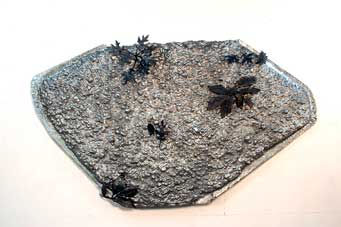
Robert Lobe, Before the Snow, 2017. Hammered galvanized iron, stainless steel. 60.5 x 104.5 x 10.5 in.
That last point is critical, for Lobe has introduced to the creative world an industrial process which, while more commonly utilized in aircraft technology, is critically important to the making of a work expressive of the principles inherent in the artist’s base material. Lobe takes his completed sections of repoussé to a commercial heat-treater where they are inserted into ovens. After the temperature is raised nearly to the melting point the aluminum is quenched in water. “When they come out they’re like lead,” says Lobe. “They can be bent any old way.” That malleability lasts only for around 10 hours, so Lobe has to work quickly to put his sculpture together. Once that is done and Lobe is sure all the measurements and relationships are correct, he disassembles the work and again heats the sections, this time for 12 hours at 350 degrees. The hardened sections are then ready for final assembly.
Despite his debt to Smith and Judd, Lobe departs from their view of art most obviously in his depiction of natural objects, a characteristic which marries modernity with the representational. “Because of the trees, my work has always had an anthropological aspect,” he says. “The minute you start to work with a section of a tree, art gets figurative.” If he departs from modern orthodoxy, he emphasizes that the ideas of Judd and Smith were for him more guidance than dictat. “It’s true that I came to my subject matter through formalism,” he says, referring to Judd’s and Smith’s passion for sculptural purity. “But formalism, for me, was just a way to understand the dynamics of art, to understand what I was working with. It didn’t have any value in itself.” He notes that his work, from the time of his early ventures in kinesthetic art, has always been sensual and tactile. “Formalism was never my religion.”
Whether a work of art obeys a set of maxims, however, is less important than whether it satisfies the demands of its containing principles. Lobe’s work has been referred to as iconotopography for the way its natural symbols contain and communicate native forces. “That is the underlying meat and potatoes of my work,” he says. “You can talk about realism and abstraction all day, but it’s really about where the art comes from that’s important. All these things go into a melting pot, and they turn into art.”
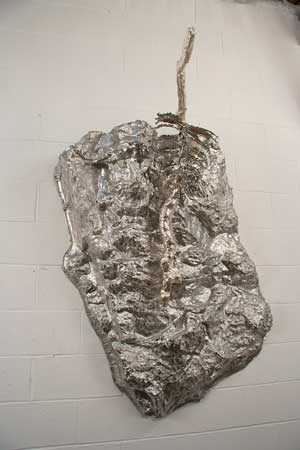
Robert Lobe, Forest Moonlight, 2017. Hammered aluminum, silver, stainless steel. 55 x 44 x 26 in.
Lobe broke away from the strictures of formalism by staying true to his desire to render nature. “My work is like a three-dimensional photograph which shows nature just the way I saw it,” he maintains. What the artist sees, however, is more than the surface representation viewed by the casual observer, but includes normally unseen energies, filtered through a lens of the artist’s experiences. It is the challenge of the artist to render this ineffable image in a way that communicates what Lobe calls the “irresolvable tension” between the unchanging inorganic rock and the evolving organic tree. This tension seems to suggest, and in the real presence resolve, the inner tensions of human relationships.
Lobe’s sculpture creates in the mind of the viewer what Smith had identified as an eidetic image, a true perception of the real world resulting from a poetic transposition of the natural object informed by what Smith referred to as “train of hooked visions,” a complex of sensations remembered from the past. This cognitive construct is the central idea informing Lobe’s sculpture. By impressing into the substrate an eidetic image evidentiary of a natural object’s internal principles rather than representative of its surface appearance, Lobe’s employment of repoussé addresses the modern sensitivity to the conflicting demands of figure and form. The resulting sculpture is neither comforting nor easy, but demands from the ambitious viewer a degree of formal involvement equal to that of the artist of origination. A successful engagement brings about a valuable cognitive state, a resolution of native human tensions through the medium of natural forces. “I’m trying to make sense out of things,” says Lobe. “I’m trying to put together a world for people to understand that hasn’t been put together before, so they can look at things in a new light and think about them differently.”
Essay by Walter Idlewild.
Images courtesy Robert Lobe.
Public collections of Robert Lobe’s works
(* denotes an outdoor installation).
General Services Administration’s Art-in-Architecture Program, US Geological Survey Building, Reston, VA, 1996*
Niagara Frontier Transportation Authority, Amherst Station, Buffalo, NY, 1984*
Laumeier Sculpture Park, St Louis Missouri, 1995*
Albright-Knox Art Gallery, Buffalo, New York
Allen Memorial Art Museum, Oberlin, Ohio
Brooklyn Museum, Brooklyn, New York
Castellani Art Museum, Niagara Falls, New York
The Cleveland Museum of Art, Ohio
The Contemporary Museum, Honolulu, Hawaii
Detroit Institute of Arts, Michigan
De Cordova Museum and Sculpture Park, Lincoln, Massachusetts*
Honolulu Academy of Art, Hawaii
Indianapolis Museum of Art, Indiana
Mihama-cho Public Sculpture, Mihama-cho, Japan*
Milwaukee Art Museum, Wisconsin
Museum of Contemporary Art, Los Angeles
Museum of Fine Arts, Houston, Texas
National Gallery, Washington, D.C. (Vogel Collection)
Newark Museum, Newark, New Jersey*
Solomon R. Guggenheim Museum, New York
The Menile Collection, Houston, Texas*
Storm King Art Center, Mountainville, New York
The Whitney Museum of American Art, New York
Works Cited
Judd, Donald. “Specific Objects.” Donald Judd Writings. Judd Foundation, 2016.
Smith, David. “The Language is Image,” “The New Sculpture,” “The Artist in Society.” David Smith: Works, Writings and Interviews. Ed. Sarah Hamill. Barcelona: Ediciones Poligrafa, 2011.
Smith, David. “The Concept of Vision.” David Smith by David Smith. Ed. Cleve Gray. Thames and Hudson, 1968.
Unattributed statements by Robert Lobe were recorded during interviews with Walter Idlewild in March and April of 2017.
Posted April 6, 2017

